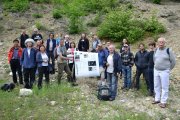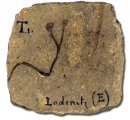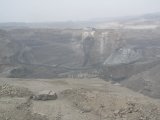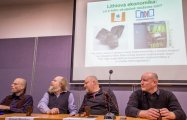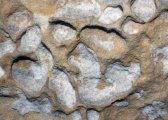News archive
News older than one year.
Discovery of specific volcanogenic structures in basaltic rocks of the Faroe Islands
The Faroe Islands (Føroyar) are formed by several thick series of subaerially emplaced plateau basalts of Palaeogene age. During the systematic volcanological survey of the Faroe Islands conducted since 2014, actively participated by Assoc. Prof. RNDr. Lukáš Krmíček, Ph.D. of the Institute of Geology of the Czech Academy of Sciences, unusual volcanogenic structures occurring on the surface of a basaltic dyke located on the Sandfelli mountain ridge (754 m a.s.l.) were discovered. The rock wall of the dyke is covered by a dense mosaic of angular to rounded polygonal convex structures designated as pseudo-hieroglyphs. The discovery of pseudo-hieroglyphs, which probably represent unique examples of a chaotic stage of horizontal columnar jointing developed in basaltic rocks, has been described as a part of a worldwide natural heritage in the recent issue of the Geoheritage journal.
A new weathering form in sandstone
A recently published paper in Earth-Science Reviews (IF 7.051), which was also contributed by scientists of the Institute of Geology (Michal Filippi and Jiří Adamovič), presents a newly recognized weathering form termed arcades. The arcades develop on the surface of sandstones but also arkoses, granites and volcanosedimentary rocks as a consequence of “stress shadows” developed along planar discontinuities (i.e., bedding planes, joints, etc.). Using physical and numerical modelling, this paper evidences that it is a principal feature of weathering of granular rocks, which explains also the origin of other widely known geomorphic forms of various sizes – such as rock pillars, some rock shelters or ledges.
Berriasian Working Group Meeting 2018 organized by the Institute of Geology CAS, v.v.i.
An international meeting of scientists interested in dating of rocks in the Jurassic/Cretaceous boundary interval (Berriasian Working Group Meeting) was organized by Petr Schnabl, the head of the Laboratory of Palaeomagnetism, in May 2018. The conference was held at Kroměříž and was attended by another 5 scientists of the Institute of Geology of the Czech Academy of Sciences, colleagues from Charles University, Czech Geological Survey, Technical University in Ostrava and scientists from Slovakia, Poland, United Kingdom, France, Bulgaria, Hungary and China. This time interval is highly topical because the Jurassic/Cretaceous boundary is the last boundary between two stratigraphic systems which has not been conclusively defined by a stratotype of the International Commission on Stratigraphy yet. The latest results of integrated research were presented and fieldtrips were made to important sites in the Czech Republic (Kurovice Quarry and Štramberk). For photo gallery click here.
News in karst research at the Institute of Geology
Staff of the Institute of Geology of the Czech Academy of Sciences have been long participating in the exploration and research in karst areas, not only in the Czech Republic. Their effort resulted in discoveries of new caves, abysses and other karst phenomena, and yielded considerable scientific knowledge. A few days ago, the media released two interesting news documenting the cooperation of the Institute of Geology within speleological-geological projects. One of these activities brought a major discovery of new large caves in central China (for details click here and here). Another news relates to the co-operation on cave research in the Krkonoše Mts. (for details click here and here).
Cooksonia barrandei – the oldest known terrestrial vascular plant
Cooksonia barrandei, the oldest known (432 million years old) terrestrial vascular plant, was described by a team of authors including Milan Libertín, Jiří Bek and Petr Štorch of the Institute of Geology of the Czech Academy of Sciences. The paper was published in the scientific journal Nature Plants (IF 10.300). For more details see the original paper or an article of the popular scientific journal Vesmír supplemented by a video (in Czech).
Study of Permian plant Pompeii in Wuda, Inner Mongolia, China
Two scientists of the Institute, Jiří Bek and Jana Frojdová, participated in the research of flora of „Pompeii in Wuda“ in November 2017. Uncovering of the Permian tropical forest was made special by frosty temperatures of minus ten degrees Celsius during the excavations. The difficult weather conditions were rewarded by the discovery of various species of ferns, sphenopsids, primitive conifers and also rare genera of Pterophyllum and Tingia. These Permian plants were studied by our scientists in the depository of Chinese Academy of Sciences in Nanjing. Now, they are processed in detail at the Institute of Geology CAS.
Not only a small experimental catchment suffered a loss
In preparations for the next field sampling at a reference site, which has been monitored for more than 25 years, we received a sad news about our colleague. Assoc. Prof. Petr Skřivan who started the monitoring of the Lesní potok catchment will not join us. We will miss Petr’s attitude, his great knowledge and merry nature. The coming field sampling campaign will be sad for us but we will be thinking of Petr this time and at all future occasions.
Lithium economy - what are the benefits?
Lithium is currently one of the most often discussed raw materials for modern technologies. Efficient storage and conversion of energy from solar and wind power plants, as well as promotion of electromobility will increase the demand for Li batteries. The Bohemian Massif represents a positive geological Li anomaly within Europe and contains the largest potential Li sources within the European Union - the Cínovec/Zinnwald deposit in the Krušné hory/Erzgebirge Mts. Discussion about the technical possibilities and economic benefits of planned lithium mining at Cínovec has become a political problem in recent months. In order to return the discussion to the subject-matter, the Masaryk Democratic Academy and the Ecological Platform Zvonečník organized a panel discussion on February 7, with the participation of representatives of the potential mining company, local government, and experts in the field of economic geology from the Academy of Sciences and the Czech Geological Survey. The lecturers and the present audience agreed on the positive contribution of the potential mining and processing of lithium for the regional development of northern Bohemia and called for a substantive approach in the search for a consensus allowing an efficient use of the Cínovec deposit.
What factors determine which part of the cliff will be “eaten” by salt crystals?
Numerous small pits on cliff surfaces have been noted by almost everyone who visited some of the sandstone rock cities. These pits are called honeycombs. Long ago, they were believed to form by wind erosion. For some time already, they have been understood to be shaped by a different mechanism: their origin is largely contributed by the crystallization of salts from groundwater/pore waters. A paper on this topic was released in the February issue of the Geomorphology journal: it brings additional evidence for the origin of honeycombs and, using dye experiments, documents the crucial role of the reach of hydraulic field in this process. This field, or, more exactly, its margin (i.e., the evaporation front) controls the sites of salt crystallization hence also the way the cliff surface is shaped by the salts. More information can be found in the paper, which was also contributed by scientists of the Institute of Geology: Michal Filippi as a co-author, and Jan Rohovec and Šárka Matoušková as analysts.
In memory of Jiří Fiala
This week, we learned a very sad news about the death of our colleague ing. Jiří Fiala, CSc.
Jirka graduated from University of Chemistry and Technology in Prague in 1961. His whole professional life was connected with the Academy of Sciences. He completed his post-graduate studies in the Institute of Geochemistry and Mineral Resources of the Czechoslovak Academy of Sciences. After the re-organization of the Czechoslovak Academy of Sciences, he was working in the Institute of Geology until his death. He was the Director of this institute in years 1991–1993. From the year 2008, he was an emeritus scientist of the Czech Academy of Sciences.
Jirka was a very successful scientist, measured by his publications. He specialized in geochemistry and petrology of metamorphic and magmatic rocks. In his research, he collaborated with many colleagues from abroad. Besides others, he can be credited for the foundation of the laboratories of mineral separation at the Institute of Geology.
Jirka had very open and friendly relationships with his colleagues, always willing to share his broad field experience and scientific knowledge.
With Jirkaʼs decease, the Institute of Geology as well as Czech science are losing a significant scientist and an outstanding personality. May the memory of him be honoured.
The last respect will be paid in the Church of the Most Sacred Heart of Our Lord in the main cemetery of Vimperk at 1 p.m. on Friday, February 16, 2018.




